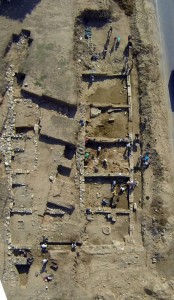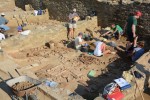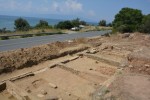 A joint Greek-Canadian archaeological team has unearthed an ancient portico in the ancient city of Argilos, northeastern Greece. It dates to the 6th century B.C., the Greek Archaic period, which makes it a rare survival and the oldest portico ever discovered in northern Greece. Hellenistic period (3rd-1st centuries B.C.) porticoes are much more common.
A joint Greek-Canadian archaeological team has unearthed an ancient portico in the ancient city of Argilos, northeastern Greece. It dates to the 6th century B.C., the Greek Archaic period, which makes it a rare survival and the oldest portico ever discovered in northern Greece. Hellenistic period (3rd-1st centuries B.C.) porticoes are much more common.
Early porticos were single-story open colonnades built as public spaces overlooking the city’s central public square, the Agora. Merchants set up shop in portico chambers, as did artists and philosophers. One philosophy even got its name from the structure. The Greek term for portico is stoa, and Zeno of Citium taught his philosophy in the Stoa Poikile, adjacent to the ancient Agora of Athens. This was a significant choice because it meant Zeno was teaching the public out in the open rather than in private schools. It was such a crucial element that Zeno’s school of philosophy became known as Stoicism.
 The section of portico uncovered thus far is 40 meters (131 feet) long. Because of the impressive length of the structure, the team used a quadcopter, a four-rotor radio-controlled model aircraft, to take aerial pictures of the complete stoa. As if getting to excavate a find like this weren’t enough fun on its own. Five rooms have been unearthed; archaeologists believe there were seven rooms originally. Each room is five meters (16.4 feet) wide and 7.5 meters (24.6 feet) deep with a back wall 2.5 meters (8.2 feet) high. Although their dimensions are uniform, the individual rooms were constructed with different materials and methods. This is important evidence of how the portico was built and by whom.
The section of portico uncovered thus far is 40 meters (131 feet) long. Because of the impressive length of the structure, the team used a quadcopter, a four-rotor radio-controlled model aircraft, to take aerial pictures of the complete stoa. As if getting to excavate a find like this weren’t enough fun on its own. Five rooms have been unearthed; archaeologists believe there were seven rooms originally. Each room is five meters (16.4 feet) wide and 7.5 meters (24.6 feet) deep with a back wall 2.5 meters (8.2 feet) high. Although their dimensions are uniform, the individual rooms were constructed with different materials and methods. This is important evidence of how the portico was built and by whom.
Since Argilos was prosperous, it is plausible that the portico was commissioned and built by the city. If this were the case, an architect would have overseen the construction and architectural integrity of the structure; there would have been no differences in the size of the stones used, and all the rooms would have been identical.
However, examination of the remains indicates just the contrary.
“The construction techniques and the stones used are different for one room to another, hinting that several masons were used for each room,” [Professor at the University of Montreal’s Centre of Classical Studies Jacques] Perreault said. “This indicates that the shop owners themselves were probably responsible for building the rooms, that ‘private enterprise’ and not the city was the source of this stoa.”
Argilos was very prosperous indeed in Archaic Greece. Perched on the Aegean coast at the mouth of the Strymon River, the area was a rich source of gold and silver. With port access for shipping, fertile alluvial land for farming and a vast supply of precious metals to mine and trade, Argilos was one of the wealthiest cities in the region. Its prosperity peaked in the 5th century
 Located on the edge of the Aegean Sea, the ancient city of Argilos was the first Greek colony established in this area around the great Strymon River. At its peak in the 5th century BC, Argilos was one of the richest cities in the region. When the Athenians founded the city of Amphipolis less than four miles away in 437 B.C., Argilos began a rapid decline. When Philip II of Macedon conquered the area in 357 B.C., he moved the population of Argilos to his new regional capital Amphipolis. The city was left deserted and was never repopulated.
Located on the edge of the Aegean Sea, the ancient city of Argilos was the first Greek colony established in this area around the great Strymon River. At its peak in the 5th century BC, Argilos was one of the richest cities in the region. When the Athenians founded the city of Amphipolis less than four miles away in 437 B.C., Argilos began a rapid decline. When Philip II of Macedon conquered the area in 357 B.C., he moved the population of Argilos to his new regional capital Amphipolis. The city was left deserted and was never repopulated.
This kind of demise is always a boon to archaeologists since they don’t have to deal with multiple layers of construction and habitation. The collaboration between archaeologists from the University of Montreal and the Ephoria of Prehistoric and Classical Antiquities of Kavala to explore Argilos’ ancient remains has been ongoing since 1992. Students from universities in Canada and Europe apply to participate in the seasonal digs and get a hands-on education from professional experts in many fields of Greek archaeology from architecture to ceramics to numismatics.
Check out the project website for more information about the history of the site, excavation and, if you’re the luckiest bastard in the world, to fill in an application for the 2014 excavation.
If the road had gone in just a few feet farther inland it would be a much different story. At the time the road went in, I’m sure they would have just chucked the pieces of stone into the sea…Makes my blood run cold to think of it.
So, so true. I’m hoping there’s an ancient road under that road and that it was left basically intact.
Ancient World still contains a lot of hidden mystery which nowadays people still have not discovered 😎 .
Ancient Greek – Macedonia – Serres – Kerdillia
http://argilosancientcitykerdilliaserres.blogspot.gr
http://makedonikoitafoikerdillia.blogspot.gr/2014/10/blog-post.html